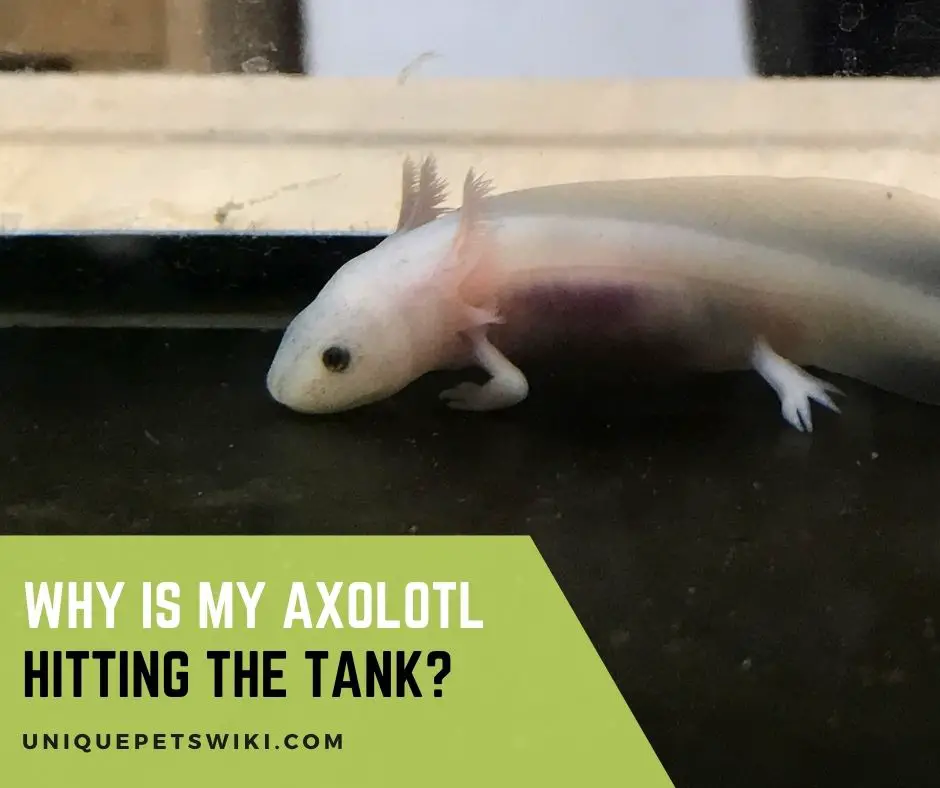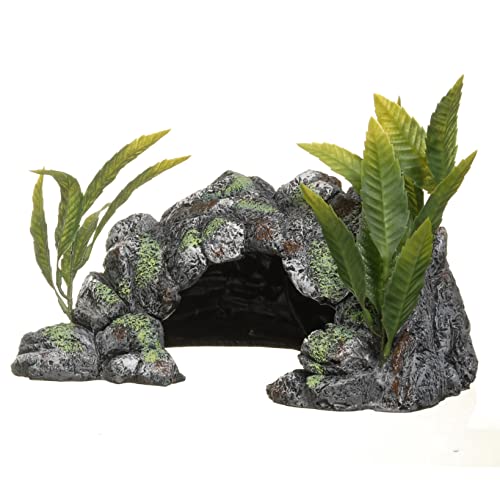Is your axolotl hitting the tank? Well, this is a problem that some axolotls owners might experience.
As a responsible owner, you might wonder or worry because your axolotl is hitting its tank. This behavior might be unusual, which leads you to think of the worst possible scenarios.
After reading this article, you’ll know why your axolotl is hitting the tank, and you’ll also be able to know what to do when your axolotls do this. We’ll give you steps to avoid this amongst other related concerns.
Contents
Why Is My Axolotl Hitting the Tank?
Axolotls hit their tank because of poor water conditions, stress, and tank problems. The toxin levels might be high and are causing significant stress to your pet axolotl. Although it is not a grave problem, you should be worried if it becomes frequent as it is a sign of stress.
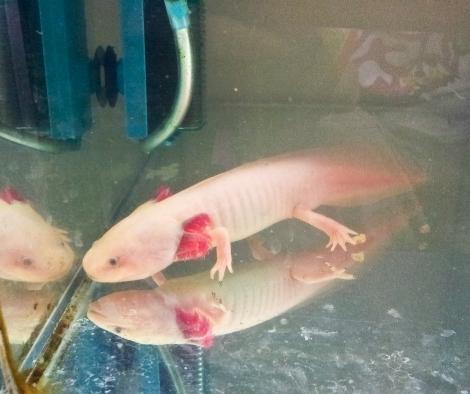
New House
If your new axolotl hits the tank, you should not worry too much. As they are brought to a new environment, it is only standard that they will need time to get accustomed to their new tank. They might swim around and explore while hitting the tank from time to time.
Young axolotls are also more energetic. They might swim around more and could accidentally hit the tank while doing so.
However, if your axolotls still hit the tank frequently after some time in their new tank, there might be underlying problems, and your axolotls are stressed. It is best to identify these problems immediately.
Blind
Axolotls have poor eyesight or blurry vision, which are very sensitive to light because of the lack of eyelids. They only use their senses to detect movements and find food.
In rare cases, an axolotl might be blind. In this scenario, it is ordinary that they will hit the tank from time to time because they can’t perceive their surroundings. But even if your axolotl is not blind, they can accidentally hit their tanks because of their poor eyesight.
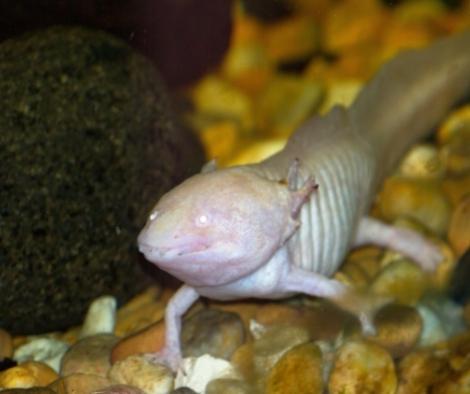
Bad Water Condition
Frantic swimming is a sign of stress or sickness for axolotls. This behavior may lead to them accidentally hitting their tanks. The leading cause of frantic swimming is terrible water conditions.
So, if you want to stop your axolotl from hitting the tank, you should ensure that the tank’s water is in good condition.
You can use aquarium testing kits to conveniently check the pH level and other conditions that affect your axolotl. The ideal pH level for axolotls is 7.4-7.6; going outside the range could lead to ammonia toxicity which is fatal for axolotls.
Aside from the water conditions, such as pH levels, it would help if you also emphasized the water temperature. The aquarium’s water temperature should not exceed 22°C as inappropriate temperatures could make your axolotls stressed or sick.
Axolotls typically enjoy calm waters, so if the current is too strong, this could also stress them. You can add decorations to block the current or adjust your tank’s filter to reduce the current it dispenses.
Axolotls produce a lot of waste, so toxins such as ammonia spike. Ammonia is hazardous for your axolotl. High ammonia levels could also lead to curling or deterioration of the gills of axolotls, a sign you should look out for.
If you notice these signs on your axolotl, you should immediately check the tank’s water condition. The curling of an axolotl’s tail can be a severe sign of illness. Hitting the tank is also one of the signs of stress for axolotls; checking the water condition is a solution.
API Water Test Kit
- Contains one (1) API FRESHWATER MASTER TEST KIT 800-Test Freshwater Aquarium Water Master Test Kit, including 7 bottles of testing solutions, 1 color card and 4 glass tubes with cap
- Helps monitor water quality and prevent invisible water problems that can be harmful to fish and cause fish loss
- Accurately monitors 5 most vital water parameters levels in freshwater aquariums: pH, high range pH, ammonia, nitrite, nitrate
- Designed for use in freshwater aquariums only
- Use for weekly monitoring and when water or fish problems appear
Last update on 2022-12-30 / Affiliate links / Images from Amazon Product Advertising API
Bad Tank Condition
One of the reasons your axolotl is hitting the tank is that it might be too small or crowded for them. Do not worry about your axolotl being lonely; keeping one axolotl in a tank is best.
An axolotl needs a lot of space because it produces lots of waste. It would help if you considered transferring them to a bigger tank to give them more room to move and grow.
Axolotls are also very sensitive to light. So, it would be best if you considered putting it in a dimly lighted place. Adding a cloth or drape to their tank should also be beneficial to reduce light. You can also put decorations inside the tank for the axolotls to hide.
Of course, keeping the tank clean is also a must in caring for axolotls. They produce lots of waste, and it would increase the toxin levels inside the tank if not cleaned.
Marina Decor Polyresin Cave, Large
- Decor cave for your aquarium
- Includes three Amazon sword plants
- Safe and non-toxic
- Natural and realistic appearance
- Measures 5.1-inch length by 11.4-inch width by 7.7-inch height
Last update on 2022-12-29 / Affiliate links / Images from Amazon Product Advertising API
What Should You Do If Your Axolotl Keeps Hitting the Tank?
Hitting the tank might be a sign of stress for axolotls. One of the main reasons for their anxiety is the water quality in their tank. You should frequently check and test the water parameters to see if everything is in order.
Axolotl is light-sensitive, and they prefer hiding. Consider adding more decorations and hiding places for your axolotls. You should also adjust the light and ensure it is not too bright for your pet; a cloth on their tanks is a great way to reduce light.
Their tank might be too small or crowded for them. Consider putting them in a bigger tank and isolating them from others.
Seaclear Gal Acrylic Aquarium Combo Set
- Combo means: The Aquarium and LED lighting are both included. The LED lighting is 24" and expands to 30".
- SeaClear Acrylic Aquariums are clearer than glass aquariums and has exceptional clarity allowing unobstructed views of the underwater environment you create
- Acrylic is 17 Times Stronger than Glass and half the with of glass aquariums. Much more Impact Resistant making it less prone to chipping or cracking than glass, making it safer around children and pets
- Black means the back of the aquarium is black, it also comes in blue back or clear back. The color enhances the beauty of the fish, decoration and plants. Safe for Salt or Freshwater
- This Sea Clear Aquarium is beautiful and you won't believe how your fish and decorations will pop when viewing your aquarium
Last update on 2022-12-29 / Affiliate links / Images from Amazon Product Advertising API
Axolotl Hitting the Tank and Related Problems
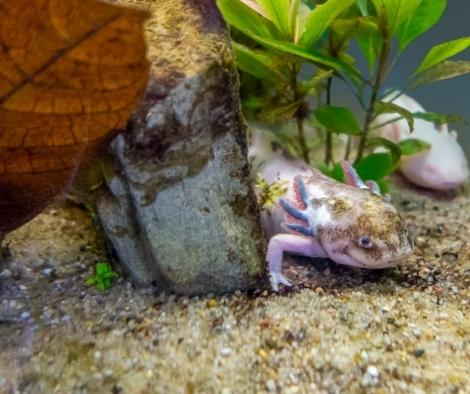
Overactive axolotl
Young axolotls are energetic, and they will swim around a lot. Some axolotls are also more active than average. If your axolotls are healthy and do not display any signs of stress, then it is normal.
However, if this is a sudden behavior change, you might consider finding the reason for this sudden change. Overactivity can be a sign of stress in some instances.
Axolotl running into glass
Swimming against the glass for long periods is a general sign of a stressed-out axolotl. Check the water and tank conditions for any problems.
However, if your axolotl is new, this is just a regular behavior as they are still exploring and adjusting to their new tank.
Axolotl thrashing
Thrashing around is a sign of discomfort for axolotls. You should be worried and immediately look into what’s causing pain to your beloved pet. This could be from irritation (gills, injury) or digestive issues such as constipation.
Axolotl shaking head
Just like thrashing, shaking their head is also a sign of discomfort. It could also be from irritation, illness, or other factors. Something is stressing them up, and it could be the water conditions, so check it immediately.
Wrapping Up
Overall, it is no reason to worry if your axolotl is new or young. New axolotls might just be adjusting and exploring their new tank. While young axolotls tend to be too energetic, and they might swim around a lot and hit the tank sometimes.
However, axolotls hitting their tank could also be a sign of stress. It could be because of bad water conditions, or their tank is too small or crowded.
It is always essential to test the water conditions in your tank. The temperature should be maintained below 22°C. The toxin levels should be monitored as they could be harmful to your pet.
Axolotls are best to be left alone. They also need hiding places and prefer low light. If they are hitting their tanks, it might be good to consider putting it in a bigger tank.
